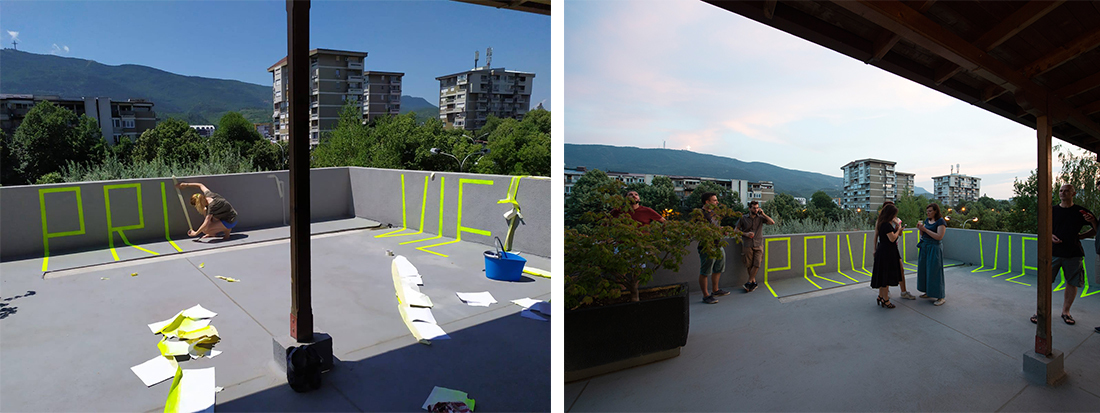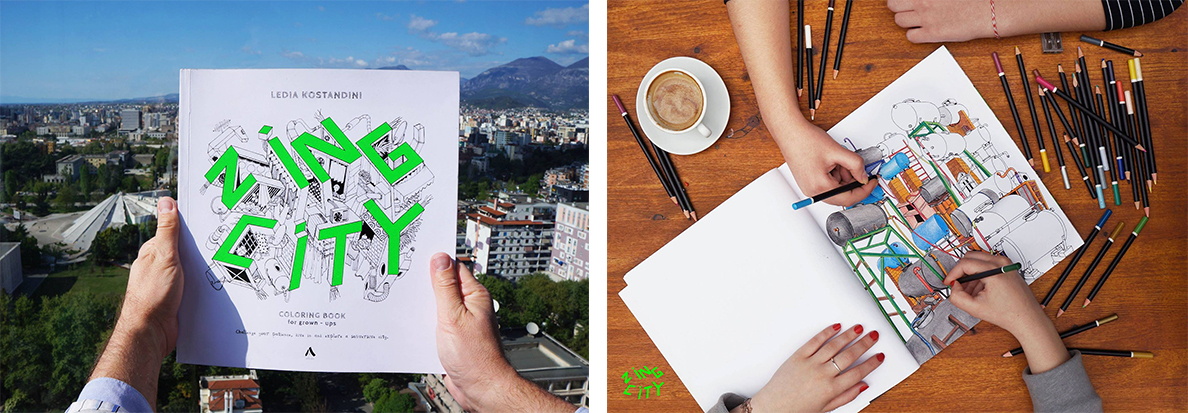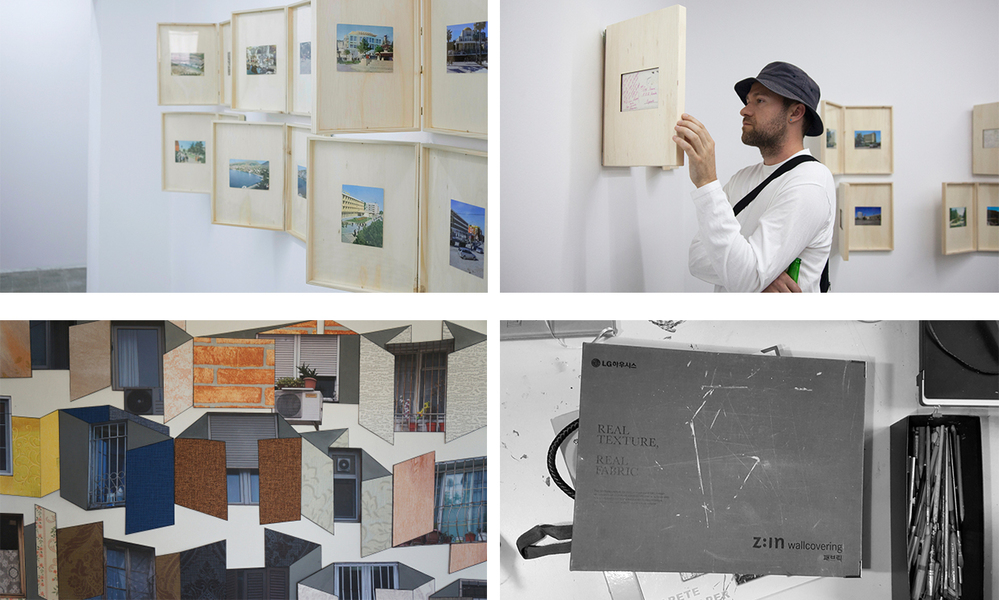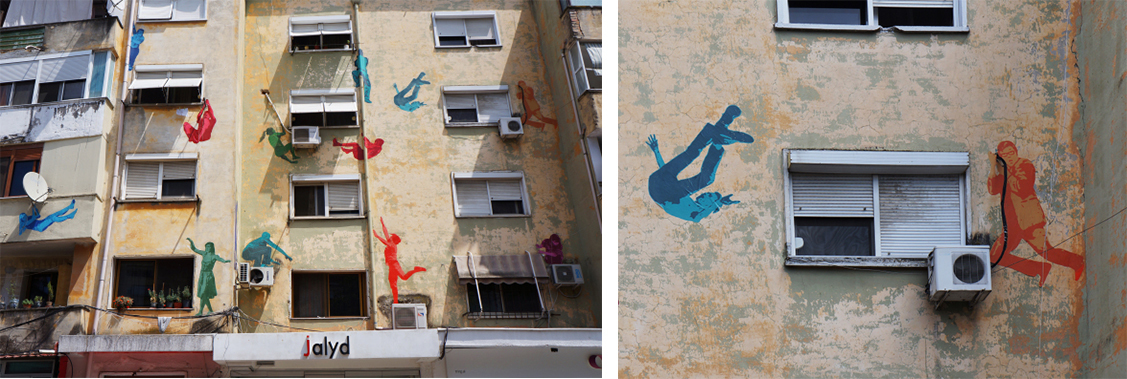LEDIA KOSTANDINI TALKS ABOUT THE BOOK, THE MATERIAL AND THE PUBLIC SPACE IN HER PRACTICE
Published on: 30.07.2019
A conversation by Ilija Prokopiev with Ledia Kostandini a result of an e-mail correspondence in the period of July, 2019, right after the opening of her exhibition I look at them, they look back at me at PrivatePrint studio.

Private view, a site-specific, graffiti art-work by Ledia Kostandini (exhibition: I look at them, they look back at me, PrivatePrint studio). Photos: Ilija Prokopiev, Zoran Shekerov
I want to start with a question that came to my mind while we were talking at the balcony of PrivatePrint studio at the opening of your exhibition I look at them, they look back at me. At one moment you said that at the beginning the whole idea for the exhibition (and the works) was to be a book, you were thinking in the medium of the book. So I am interested to know why and how was all of that imagined?
Being fascinated by architectural forms, I am always investigating different structures of it, obviously not for some kind of technological or engineering reason. Throughout these solid structures, I aim to decipher a certain nonverbal communication that humans use, to express thoughts and feelings in the public space. In this context, I thought about collecting several impressions that meet the idea of the “balcony”, as a hybrid architectural structure which stands on the borderline between our private and public space. I started developing the project called Narrations of a balcony. It was planned to be a kind of a diary that keeps track of my observations in the form of words, photos and sketches. Even though these recordings were not part of a single sketchbook, I started envisioning it as a whole. I was planning to do a 30-pages book, a monthly report of metaphors and mind images of the balcony.
When I received your invitation, for a solo show at PrivatePrint studio, I immediately thought of involving this project in your space. As an artist, I like engaging with spaces and consider it a very important part of the whole work. I have worked previously with site-specific projects and exhibitions. So, when I decided to show pieces of the project Narrations of a balcony, I was aware it would start to develop in different forms and mediums according to the space itself. And so, it did! For instance, certain sketches were developed in installations, others in video-installations. The exhibition came to be the re-elaboration of my initial thoughts, into a mixed media collection of works that aimed to embrace the white-box space. Through this long process, I’ve learned a lot when it comes to the endless possibilities a subject has, to get shaped according to structures, be it a room or a book. The book-project still sits on my mind, but today it is slightly different from my previous plans. The exhibition made me think differently about forms of expression. On the way, I have met new ideas and reconsidered old ones.

Exhibition: I look at them, they look back at me by Ledia Kostandini, PrivatePrint studio. Photos: Zoran Shekerov
So the book plays important part in your artistic practice in general?
I started to work as an independent illustrator almost 10 years ago. Since then, I am thinking about bookmaking on a daily basis, because I usually take commissions not only for illustrations, but for conceptualization of a book as a whole. Until some time ago, I have always positioned this job on a second plan, in terms of artistic priorities, and didn't "allow" myself to get much involved emotionally in bookmaking rather than in different mediums of art-making. I was keeping a straight separation line between my two activities: illustration and art-making, always saving my best thoughts and moments for art projects. Over the years, I noticed something very interesting. People started recognizing my name and my work, much more as an illustrator, rather than as an artist. It was strange and yet satisfying to know that people of different ages and places where familiar with my books, also because it was something I never aimed for, never thought of. I started wondering about the unlimitedness of books in terms of space and time. Books have this ability to multiply in hundreds of copies, travel endlessly your thoughts and messages, meeting people beyond your physical reaches.
I started thinking about book as a very versatile medium of art, how I could merge my job as an illustrator with my art research. In this setting, I published Zing City, a coloring book that aims towards the interactive feature books have. Meanwhile I started working on other (ongoing) book project ideas.
One of these projects is called 60 possibilities of a window. I am practically generating metamorphosis of a window in 60 different pages. The most interesting part of this book is the reverse working process I am using. Instead of applying the material to the idea of the book, I am applying the idea over the material. The book-body is actually a fine papers' catalogue that I was given some times ago. I decided to use the diversity of these catalogue pages, to create minimalist cutouts that interconnect and transfer to one another.
Is 60 possibilities of a window going to be a single handmade book?
This is the right question to ask when it comes to such a book. It is completely handcrafted and uses ready-made pages of the catalogue itself, so my initial plan was to do something that could work as a single art piece. Nevertheless, when I stared it, I began thinking about the possibilities it might have to get multiplied. Considering this essential feature books have, I don’t want to stop in the “single art piece” - project but keep thinking about its publication as an artist’s book. I am aware, it might have several difficulties when it comes to its technical realization. But I am trustful that there are true possibilities to make it done, considering the vast diversity of book-kinds in our days. I would like to mention only one of my dearest references in the project. It is the fantastic cutout book of Olafur Eliasson called Your house. It’s a replica of the indoor space of a house created “page-by page”. This is an example of the book that works simultaneously as an art piece and vice versa.

Ledia Kostandini: Zing City (2017). Photos: Ledia Kostandini
Your house by Olafur Eliasson is a wonderful book, a real spatial experience set into the form of a book. As you already mention this reference, I can see how you might approach the book as a medium. It is obvious from your works in general that you are into the concepts of space. Your book Zing City is concerning the space too, fragments from the city. What is the idea behind this book and why you decided to make it as a coloring book?
I am fond of activity books of any kind. They unfold the information step by step, and the public must be the one who unlocks the message, using several interactive methods. These kinds of books stand in the middle point between the author and the public. The book is a meeting “place” for mental and practical exchanges among them. Back in 2016, I became a fan of adult-coloring books that were a real trend in the foreign book-market. Instead, in Albania, such book has not yet emerged. As an illustrator, I had previously worked with children coloring books and knew the main principles of them, in terms of graphic elaboration. On the other hand, being a mom, I was experiencing the first coloring steps of my 2-year old son. I became more aware about the benefits of coloring, as a process that stimulates our mind and makes our unconsciousness emerge in the most colorful form. I was happy to discover that coloring was appreciated by the adult public worldwide.
Zing City previously was just a sketchbook, full of dense, detailed sketches of the cityscape. I used to draw chaotic urban sites and foolish architectural forms. When I discovered adult coloring books, I thought about the possibility of my drawings to become coloring illustrations and gave it a try. This is how I started “building” a messy and subversive city out of lively details and paradoxical constructions. I called it Zing City. I was willing to offer a whole experience to the public, not just a graphic book. Coloring the book, means reading it. But at once, it means appropriating the whole city because coloring is the expression of an aesthetic opinion (about the city). Zing City represents the energy within the stressful urban life and tents to give back to the public certain serenity out of the chaos. I consider it an unfinished book and I like the independence of its continuity; it is something I cannot control anymore. At the end, each book is going to be unique.
In most of your works and exhibitions you are also using paper ready-mades like the postcards in your exhibition Let Us Meet in Between or the wallpaper samples in Paperwalls, but also you use the paper as a medium in your site-specific installation and spatial interventions. What is behind this practice?
I have been fascinated by paper crafts since I can remember. As a child, I loved papier-mâché, collages, cutouts, pop up paper-works etc. So, I think that part of my actual practice derives from a certain unconscious level which is probably cultivated overtime. It is true I can relate big part of my practice to paper, as an essential material to many art projects. This is because I perceive it as a very suggestive source of raw information. Paper (be it blank, colorful or printed) is a ready-made object that works as an input to certain reactions. My interaction to this material differs from project to project. Sometimes I like to speculate, according to feelings or thoughts a material might provoke. For instance, Paperwalls is a mural collage that follows a certain pattern and can grow endlessly. It is a project that emerged from wallpaper sample catalogues. I was so fascinated by their diversity in textures, and patterns, that I started envisioning each page as a different room interior. I decided to follow the logics of the wallpaper itself and create a sort of “city pattern”.
When it comes to picture-paper, such as prints, photos or postcards, I relate mostly to the visual representation of the paper rather than to its physical qualities. I have a special interest in archival images, be it an old magazine, a postcard or a family portrait. I find them magical mediators of different times and use them as a starting point from which I raise questions about present issues.
In the Postcards project, my family archive of postcard correspondence becomes the point of reference for a long journey across Albania. I recaptured the same composition of sightseeing postcards, going from one city to the other, meeting people, hearing their personal story and opinion. After some years, this photographic investigation concluded in a new series of “postcards” which represent the actual situation of my country and its multidimensional transformations over the last 30 years.

Ledia Kostandini: Let Us Meet in Between (2018) and Paperwalls (2017). Photos from the artist’s web-site
When you do not work in your studio you work on public art projects, you are producing big scale works. How do you prepare and execute this works? For example, how do you choose the location, do you do the interventions legally J, what is your methodology of execution? I hope you had a scaffold when you work on Hangout ½ J?
My art practice stands in between small, intimate crafted pieces and spatial interventions. I have these two art personalities, and I cannot do anything about it. I love both approaches; they supply fresh air to one another and complement my need to contact personal and public territories.
My interventions are usually ephemeral. I use practical materials and I try to use less time possible to the realization. I like them to be in a certain transitional condition and search for unestablished sites, places that exude brutal “beauty”. I like to observe how people attack schemes and systems, generating unexpected installations all around. I get inspired by unconventional interventions people do in the public space and follow a similar logic in my projects.
I try to be accurate when it comes to permissions and make some logistic work in advance, especially when it comes to private territories. I must admit that people find it hard to understand the point of it, and when they approve, is a matter of willing to be open minded.
Most part of my site-specific projects have been unsolicited. Instead some others, such as Auto-im-mobile, Hangout or Falling blocks, have been part of collective art events. In this case I collaborate with organizations and institutions.
I must be frank, I am terrified of heights and this fact limits me in terms of execution. So, I have been always assisted in bigger projects such as Hangout which was realized by a team of talented guys from the department of Dekor of City of Tirana.

Ledia Kostandini: Hangout ½ (2017). Photos from the artist’s web-site
Do you work on a new public space project?
Actually, I am not working on any specific project in the public space because I am concentrated in the finalization of unfinished projects, such as some of the books I mentioned before. I am spending more time in the studio. Nevertheless, my mind is storming ideas and I am always willing to continue with my outdoor interventions, hopefully very soon.
\\\
Images from the exhibition I look at them, they look back at me - LINK
Ledia Kostandini, web-site - LINK